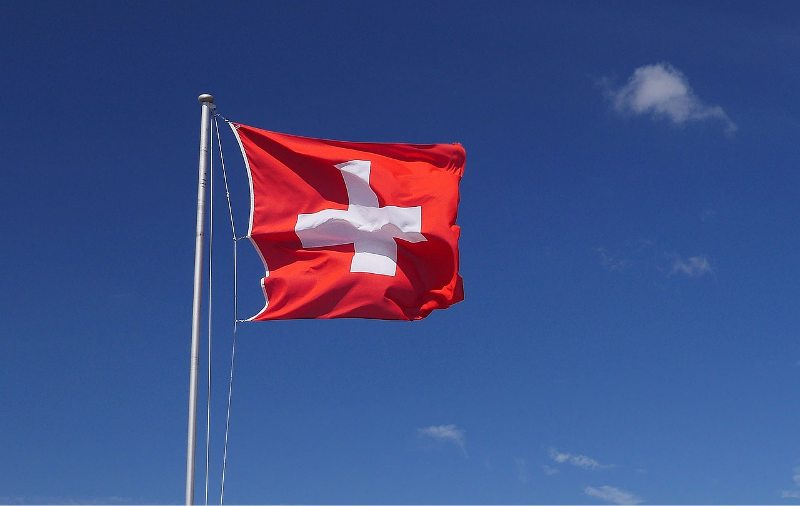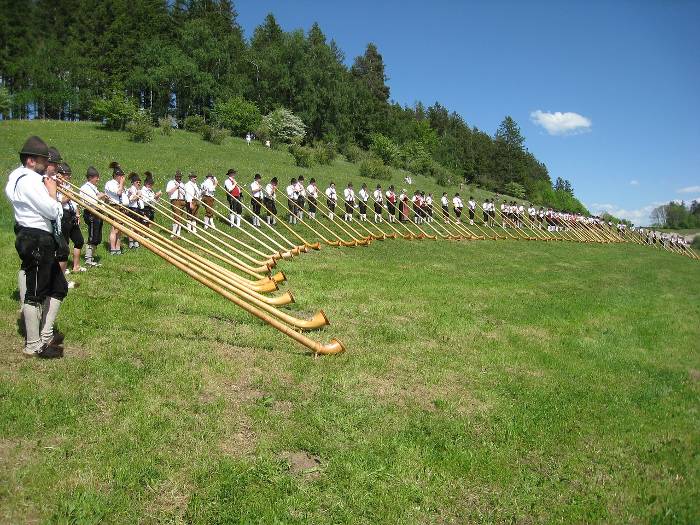Curious about Swiss national symbols? Then you are definitely in the right place because this detailed guide covers all the symbols that are used to represent Switzerland and the Swiss people!
The national flag, national coat of arms, and the national anthem are the three main symbols of the country, but they’re not the only ones that exist. Read on to learn about all the other Swiss national symbols, and see all the different things that represent the Alpine country!
National Flag

The official flag of Switzerland is a white cross on a red background. The cross is at the center of the red field, and it is known as the federal cross or the Swiss cross. This has been the official Swiss flag since 1841, but it’s important to note the origins of the flag can be traced back to the battle of Laupin in 14th century during the time of the Holy Roman Empire.
Back then, a white cross against a red background was the insignia of Swiss soldiers, who want to stand out from other soldiers on the battlefield that day. Switzerland’s flag was occasionally used between the 14th and 19th centuries, but it wasn’t until 1889 that the design currently in use was finally set. It’s worth noting that the Swiss flag is one of two national flags that boast a square shape – the rest are all rectangular.
National Coat of Arms

Unlike in other countries, the National Coat of Arms of the Swiss Confederation is very similar to the country’s national flag. It’s a white cross against a red background, but the cross is on a red heraldic shield and not a square.
The coat of arms was defined for the Restored Confederacy in 1815, along with a more elaborate federal seal. Also, there are records of more elaborate version that date back to the 16th century, which represented all the 13 cantons of the Old Swiss Confederacy.
It’s worth noting that it wasn’t until 2017 that the Swiss coat of arms was formally declared as a “Swiss cross in a triangular shield”. The simple coat of arms had been in wide use for a long time, but it did not see much official use.
National Anthem
The Swiss national anthem is the final of the three Swiss national symbols – official ones, at least. It is the Swiss Psalm and it has been in official use since 1981. The Swiss Psalm was composed by Alberich Zwyssig in 1841, but the federal council refused to declare it as the official anthem because they wanted people’s input on what the national anthem of Switzerland should be.
The Swiss Psalm replaced Rufst du, mein Vaterland as the official anthem of the country. This had been the de facto national anthem for more than a century since the 1840s.
National Motto
The (unofficial) Swiss national motto is Unus pro Omnibus, Omnes pro Uno – One for all, all for one. It is a symbol of unity and cohesion of all the different administrative units in the country, and it can be interpreted as One (country) for all (cantons), all (cantons) for one (country).
The roots of this saying in Switzerland date back to the early 16th century, but its use became the most widespread during the natural disasters of the 19th century. A sense of unity and togetherness was needed to help the Swiss people overcome those hardships, and this maxim fit in perfectly.
National Currency

The national currency of Switzerland is the Swiss franc. The banknotes are issued by the Swiss National Bank, and the coins are issued by Swissmint, the official federal mint. Swiss banknotes are notoriously difficult to counterfeit, which is one of the main reasons why they keep printing the 1,000 CHF banknote – one of the highest-value banknotes in the world.
The notes have also been changed in 2016 to their ninth version. The process was phased in over a number of years with the 100 CHF note being the last one in September 2019. They are quite unusual in texture too, having been printed on new 3-layer material called Durasafe produced in Switzerland by Landqart.
One thing that’s special about the national currency of Switzerland is that it’s the last remaining Franc in Europe. Euros are accepted in some cantons, but even when you pay in Euros, you will get the change back in Swiss Francs.
National Animal

Switzerland doesn’t have an official animal or a national bird, but the cow is the one animal that is most widely associated with Switzerland. The country’s vast pastures as home to countless cows, and the locals in certain regions even have the tradition of walking them through the village streets during certain festivals.
Want To Save This For Later?
The cow isn’t the only animal commonly associated with Switzerland. The ibex, marmot, blackbird, and St. Bernhard were all used to represent the Swiss nation at certain points.
National Flower

The Edelweiss is the Swiss national flower, as well as the official symbol of the national tourism organization in Switzerland. It grows high up in the Alps, and it is regarded as one of the many (unofficial) national symbols of Switzerland. The beautiful flower belongs to the daisy and sunflower family of Asteraceae, and it even has medicinal uses. Edelweiss is used in traditional medicine to help relieve respiratory and abdominal diseases.
It’s worth noting that the beautiful flower is not a national symbol of just Switzerland. It is considered a national symbol of most countries where it normally grows, most notably Romania, Italy, Slovenia, and Austria.
National Tree

Pinus cembra is regarded as the Swiss national tree. This is a species of pine tree that is very common in the Swiss Alps, but it’s worth noting that you can also find it in other places in the world.
The pine tree can easily endure a wide range of temperatures, which is the main reason why it is so common in Switzerland. It’s one of a few species that can survive the extreme temperatures of the Alps.
National Dish

The main Swiss national dish is Rösti – delicious potatoes that are crispy on the outside but soft like butter on the inside. The official national dish of Switzerland isn’t even a main dish; it’s a side course that is most often served with Zurich-style veal.
Rösti can be turned into a main dish – most people will just add some cheese, bacon, and onions to enhance the flavors and add more nutrients. But they’re delicious enough to be eaten on their own!
It’s worth noting that there are a few other dishes that are eaten throughout the entire country and are also considered national dishes alongside Rösti. These are cheese fondue, which is pretty much just heaven in a bowl if you’re not lactose intolerant; Raclette, which is a generous serving of melted Raclette cheese with some meat and potatoes; and muesli, a breakfast food made with oats, chopped fruit, and yogurt or milk.
National Instrument

The alphorn is the Swiss national instrument. It’s a 3.5-meter-long musical instrument of a conical shape, and it bends just like a cow’s horn (hence the name) at its end. The instrument has been in use for more than 500 years – it was mentioned for the first time sometime in the 16th century, but it is not possible to determine whether the instrument was in use before that time.
One of the main functions of the Alphorn was for shepherds to call back their herds to the stable. But the instrument has entertainment value as well, and it has been used just to create music.
Other Popular Swiss Symbols

We’ve covered all the most important symbols that represent Switzerland – now let’s move on to some other Swiss symbols that aren’t exactly official but are representative of Switzerland!
The Swiss knife. Although it is not an official symbol of the country, one cannot see the Swiss army knife without thinking of Switzerland. The iconic pocket knife is one of the most widely used Swiss products and it can be found in pretty much every country on the planet. Swiss army knives are manufactured by Victorinox, whose logo is a slightly modified Swiss national coat of arms.
Swiss cheese. Switzerland is world-famous for its many kinds of cheese, whether it’s Emmentaler, Tilsiter, Gruyere, Raclette, or any other one of the dozens of cheeses that are produced in the country. Cheese is the staple ingredient of most Swiss dishes, and you can find buckets of fondue in virtually every corner of the country.
Swiss chocolate. It’s no secret that Swiss chocolate is some of the best (and most expensive) chocolate in the world. Lindt, Laderach, Toblerone, and Cailler are just a few of the most popular Swiss chocolate brands, which are widely exported to countries all over the planet.
Chocolate is such an important part of the Swiss national identity that you can do chocolate tours of most big cities in Switzerland. They usually entail visiting the best chocolate shops in the city, trying their most popular products, and sometimes you even get to make your own chocolates!
Swiss punctuality. Punctuality isn’t necessarily a symbol of the country, but it is a very big part of the Swiss way of life. If you make plans to meet a native Swiss at 3 PM somewhere, you can rest assured that they will be there at 3 PM sharp. The country has a watchmaking history that goes back several centuries, and they’re world-famous for the fast and punctual trains. When it comes to being on time, few are as consistent as the Swiss.


